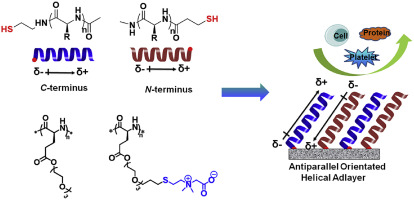Biomaterials ( IF 12.8 ) Pub Date : 2018-02-03 , DOI: 10.1016/j.biomaterials.2018.01.052 Chong Zhang , Jingsong Yuan , Jianhua Lu , Yingqin Hou , Wei Xiong , Hua Lu

|
The development of high-performance nonfouling polymer surfaces for implantable medical devices and therapeutic nanomaterials is of great importance. Elaborating the relationship of polymer structural characteristics and the resulted surface properties can offer useful guidance toward ideal biointerfaces. In this work, we investigate the effects of the helical conformation and anchoring orientation of poly(α-amino acid)s (PαAAs) to produce advanced nonfouling surfaces. By using the neutral poly(γ-(2-(2-(2-methoxyethoxy)ethoxy)ethoxy)esteryl glutamates) (P(EG3Glu)s) as a model system, the adsorption kinetics are monitored by ex-situ variable angle spectroscopic ellipsometry and in-situ quartz crystal microbalance with dissipation. It is found that the polymers adopting a rigid rod-like α-helical conformation can self-assemble more rapidly to produce denser adlayers, and generate significantly improved nonfouling surfaces compared to those flexible polymer analogues including the widely used antifouling polymer PEG. Moreover, the surface properties can be further enhanced by using the antiparallel orientated helical P(EG3Glu)s. Most importantly, the insights gained from the P(EG3Glu) model system are successfully applied to the generation of ultra-low-fouling surfaces using zwitterionic PαAAs brushes, underscoring the generality of the approach. Particularly, the surface based on the antiparallel aligned zwitterionic helical PαAAs exhibits ∼98–99% reduction of human serum adsorption relative to the bare gold, and gives almost no adhesion of mouse platelet. Taken together, this work depicts an extremely simple yet highly effective approach to manipulate surface properties for numerous applications in biomaterial interfaces, diagnostics, and biosensors.
中文翻译:

从中性到两性离子的聚(α-氨基酸)防污表面:螺旋构象和锚定方向的影响
用于植入式医疗设备和治疗性纳米材料的高性能防污聚合物表面的开发非常重要。阐述聚合物结构特征与所得表面性质之间的关系可以为理想的生物界面提供有用的指导。在这项工作中,我们调查了聚(α-氨基酸)(PαAAs)的螺旋构象和锚定方向对产生高级防污表面的影响。通过使用中性的聚(γ-(2-(2-(2-(2-甲氧基乙氧基)乙氧基)乙氧基)谷氨酸酯(P(EG3 Glu)s)作为模型系统,通过异位变量监测吸附动力学角度光谱椭圆仪和原位石英晶体微天平,具有耗散能力。发现与包括广泛使用的防污聚合物PEG的那些挠性聚合物类似物相比,采用刚性棒状α-螺旋构象的聚合物可以更快速地自组装以产生更致密的夹层,并产生显着改善的防污表面。此外,通过使用反平行取向的螺旋P(EG3Glu)s,可以进一步提高表面性质。最重要的是,从P(EG3Glu)模型系统已成功应用于使用两性离子PαAAs刷子生成超低污垢表面,这强调了该方法的普遍性。尤其是,基于反平行排列的两性离子螺旋PαAAs的表面相对于裸金表现出约98-99%的人血清吸附减少,并且几乎没有粘附小鼠血小板。综上所述,这项工作描述了一种极其简单而高效的方法,可用于生物材料界面,诊断和生物传感器中众多应用的表面性质。











































 京公网安备 11010802027423号
京公网安备 11010802027423号